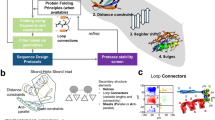Abstract
The hydrophobic/polar HP model on the square lattice has been widely used toinvestigate basics of protein folding. In the cases where all designing sequences (sequences with unique ground states) were enumerated without restrictions on the number of contacts, the upper limit on the chain length N has been 18–20 because of the rapid exponential growth of thenumbers of conformations and sequences. We show how a few optimizations push this limit by about 5 units. Based on these calculations, we study the statistical distribution of hydrophobicity along designing sequences. We find that the average number of hydrophobic and polar clumps along the chains is larger for designing sequences than for random ones, which is in agreement with earlier findings for N ≤ 18 and with results for real enzymes. We also show that this deviation from randomness disappears if the calculations are restricted to maximally compact structures.
Similar content being viewed by others
REFERENCES
Chan, H.S., Kaya, H. and Shimizu, S.: Computational Methods for Protein Folding: Scaling a Hierarchy of Complexities, in T. Jiang, Y. Xu and M.Q. Zhang (eds.) Current Topics in Computational Biology, MIT Press, Cambridge, Massachusetts, USA, 2002, pp. 403–447.
Lau, K.F. and Dill, K.A.: A Lattice Statistical Mechanics Model of the Conformational and Sequence Spaces of Proteins, Macromolecules 22 (1989), 3986–3997.
Dill, K.A., Bromberg, S., Yue, K., Fiebig, K.M., Yee, D.P., Thomas, P.D. and Chan, H.S.: Principles of Protein Folding A Perspective from Simple Exact Models, Protein Sci. 4 (1995), 561–602.
Hirst, J.D.: The Evolutionary Landscape of Functional and Model Proteins, Protein Eng. 9 (1999), 721–726.
Shahrezaei, V. and Ejtehadi, M.R.: Geometry Selects Highly Designable Structures, J. Chem. Phys. 113 (2000), 6437–6442.
Irbäck, A. and Sandelin, E.: On Hydrophobicity Correlations in Protein Chains, Biophys. J. 79 (2000), 2252–2258.
Irbäck, A., Peterson, C. and Potthast, F.: Evidence for Nonrandom Hydrophobicity Structures in Protein Chains, Proc. Natl. Acad. Sci. USA 93 (1996), 9533–9538.
Kloczkowski, A. and Jernigan, R.L: Transfer Matrix Methods for Enumeration and Generation of Compact Self-Avoiding Walks. 1. Square Lattices, J. Chem. Phys. 109 (1998), 5134–5146.
Vendruscolo, M., Subramanian, B., Kanter, I., Domany, E. and Lebowitz, J.: Statistical Properties of Contact Maps, Phys. Rev. E 59 (1999), 977–984.
Madras, N. and Slade, G.: The Self-Avoiding Walk (Birkhauser, Boston, 1993).
Chan, H.S. and Dill, K.A.: Transition States and Folding Dynamics of Proteins and Heteropolymers, J. Chem. Phys. 100 (1994), 9238–9257.
Chan, H.S. and Dill, K.A.: Comparing Folding Codes for Proteins and Polymers, Proteins Struct. Funct. Genet. 24 (1996), 335–344.
White, S.H. and Jacobs, R.E.: Statistical Distribution of Hydrophobic Residues along the Length of Protein Chains. Implications for Protein Folding and Evolution, Biophys. J. 57 (1990), 911–921.
Buchler, N.E.G. and Goldstein, R.A.: Effect of Alphabet Size and Foldability Requirements on Protein Structure Designability, Proteins Struct. Funct. Genet. 34 (1999), 113–124.
Buchler, N.E.G. and Goldstein, R.A.: Surveying Determinants of Protein Structure Designability across Different Energy Models and Amino-Acid Alphabets: A Consensus, J. Chem. Phys. 112 (2000), 2533–2547.
Irbäck, A. and Sandelin, E.: Local Interactions and Protein Folding: A Model Study on the Square and Triangular Lattices, J. Chem. Phys. 108 (1998), 2245–2250.
Yue, K., Fiebig, K.M., Thomas, P.D., Chan, H.S., Shaknovich, E.I. and Dill, K.A.: A Test of Lattice Protein Folding Algorithms, Proc. Natl. Acad. Sci. USA 92 (1995), 325–329.
Chan, H.S. and Dill, K.A.: Origins of Structure in Globular Proteins, Proc. Natl. Acad. Sci. USA 87 (1990), 6388–6392.
Abkevich, V.I., Gutin, A.M. and Shakhnovich, E.I.: Impact of Local and Non-Local Interactionson Thermodynamics and Kinetics of Protein Folding, J. Mol. Biol. 252 (1995), 460–471.
Irbäck, A., Peterson, C., Potthast, F. and Sandelin, E.: Design of Sequences with Good Folding Properties in Coarse-Grained Protein Models, Struct. Fodd. Des. 7 (1999), 347–360.
Torrie, G.M. and Valleau, J.P.: Nonphysical Sampling Distribution inMonte Carlo Free-Energy Estimation: Umbrella Sampling, J. Comput. Phys. 23 (1977), 187–199.
Shahrezaeí, V., Hamedani, N. and Ejtehadi, M.R.: Protein Ground State Candidates in a Simple Model: An Enumeration Study, Phys. Rev. E 60 (1999), 4629–4636.
Rights and permissions
About this article
Cite this article
Irbäck, A., Troein, C. Enumerating Designing Sequences in the HP Model. Journal of Biological Physics 28, 1–15 (2002). https://doi.org/10.1023/A:1016225010659
Issue Date:
DOI: https://doi.org/10.1023/A:1016225010659




